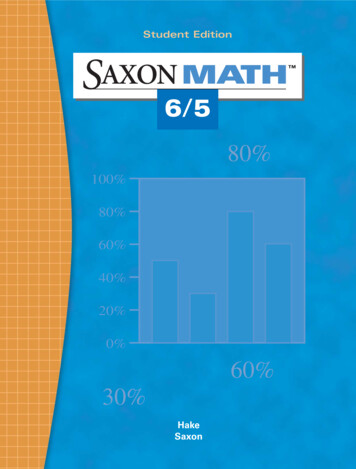
Transcription
Lesson 14. SociolinguisticsSoohyun Kwon
Overview of Today’s lecture1. What is Sociolinguistics? 2. Sociolinguistic fieldworks3. Language variation according tosocial factors4. Language change in progress5. Summary
Sociolinguistics explores The connections between languageand societyHow the use of language variesaccording to different social factors. Theway we use it in different socialsituations.
Innovative SociolinguisticsSociolinguistics Hasits roots in dialectology Emergedin the 1960s partly as a result of inadequate methods inearlier approaches to the study of dialect. Usesrecordings of informal conversations as its data (andoccasionally reading exercises to examine the role of formality indialect use) Arguesfor the role of quantitative analysis in highlighting dialectdifferences
Sociolinguistic fieldworks The most systematic grammar of a dialect resides in thevernacular language of the speech community (Labov 1972). The rapid anonymous surveys (short surveys investigatingone linguistic feature from many people in a short space oftime) Subsequent sociolinguistic interviews and analysis in arelevant community.For more details, please refer to Milroy (1987) and Milroy andGordon (2003)
Language Variationaccording to social factors
Regional Background – Canadian Raising Certaindiphthongs are"raised”before voicelessconsonants (e.g., /p/, /t/, /k/, /s/, /f/). /aɪ/ [ʌɪ]or [ɐɪ]e.g. five, like/aʊ/ [ʌu] (in the west)[ɛʉ] (in Central Canada)e.g. loud Inany case, the /a/-component ofthe diphthong changes from a low vowel to a mid-lowvowel ([ʌ], [ɐ] or [ɛ]). http://www.ic.arizona.edu/ lsp/Canadian/canphon3.html#diphthongs
Gender -HRT High Rising Tones (HRT)(using question intonationin statements) in NewZealand English (NZE)(Britain 1998)In NZE the use of HRT is verystrongly associated withyoung women, yet theyonly use the HRT 3%percent more often thanyoung men.Small quantitative differencescan signal quite importantsocial information about alinguistic variable.
Gender –g-droppingTrudgill's (1974) research in Norwich G-dropping: (ing)vs. (in) Women use standard forms of stabledialect features more frequently thanmen. Within each social class group, womenconsistently use less of the nonstandard pronunciation than men. It is the regularity of these (and other)patterns that lends weight to theargument that variability is 'structured'socially (Chambers and Trudgill 1998)
Social class-Absence of 3sg The absence of thirdperson present tensemarking (e.g. 'she play','the boy sing') withsocial classmembership in the cityof Norwich in England(Trudgill 1974) The 'higher' the socialclass of the speaker,the lower the absenceof -s marking.
Register( Formal vs.Informal)– g-droppingThe percent of /in/ variantCasual Careful ReadingLabov (1966)Podesva (2004)
Listener VariationAudience Design SpeechtheoryaccommodationSpeakers accommodate their speech styleto their hearers (Giles&Powesland 1975)e.g. talking to a baby or a foreigner Speakers adjust their speechprimarily towards that of theiraudience in order to expresssolidarity or intimacy withthem, or away from theiraudience’s speech to expressdistance.Accommodation theory also attempts tospecify the motivations which lie behinduse of particular accommodativestrategies. Approval seeking has beenrecognized as a prime motive inaccommodation. This is very powerful inmass communication, where we assumethat communicators are always in somesense trying to win the approval of theaudience (McQuail 1969b)
Language ChangeIn Progress
How do we study language changein progress ? We know language has changed over time Great Vowel Shift in Middle English:/mu:s/ /maʊs/ ‘mouse’ Do-support:I know not I don’t know Track down the speech of the same speakers for 30 years? Studying diachronic changes only?Takes a long timeHard to follow individual speakers
Apparent time method We can view synchronic age patterns as a window on whathas happened in a community over the last few generations Basic assumption: Adults speak the language they learned aschildren - Critical Period Hypothesise.g. Noam Chomsky b. 1928 : He speaks the language helearned 60-70 years ago. Compares speakers of different ages (who had acquiredlanguage at different points in time) Shortens the length of time required to conduct the research,.(Labov 1963, 1966)
Critical Period Hypothesis (CPH): Basic assumption of Apparent time method People'sdialect remains fairly stable from adolescenceonwards Butquestions have been raised about CPH. TheOpposition to CPH e.g. Englisht/d deletion (Guy1980, Guy & Boyd 1990)Alveolar stop Ø after a consonant at the end of a syllablee.g. best friend /bεs frεn/
Critical Period Hypothesis (CPH): Basic assumption of Apparent time method ‘Semiweak’ verbs have a vowel change as well as a suffix in thepast tense keep kept, tell told, sell sold, feel felt With semiweak verbs in particular, age plays an important rolein t/d deletion The older the speakers, the less likely they were to delete t/d insemiweak verbs Observed speech in a 4-year-old girl:and then I started /startId/ crying and then I screamed /skrimd/ and then daddy yelled /yεld/ at me.but I kept /kεp/ on crying
Critical Period Hypothesis (CPH): Basic assumption of Apparent time methodt/d deletion is a case of late acquisition, showing agegrading effect Kids don’t realize that there’s a past-tense -ed on semiweakverbs at all – they think the past tense of keep is just /kεp/ Much later in life – perhaps well past the critical period –speakers learn that semiweak verbs do have a -ed suffix. Speakers then apply t/d deletion at the same (low) rates aswith the regular past-tense -ed.
Example of Apparent time method Theuse of intensifier in Englishe.g. He is Ø smart.He is very smart.He is really smart.He is so smart.
Apparent time method –The use of intensifier inTorontoEnglishVery is the most frequently usedintensifier in the speakers over 50,but declines rapidly thereafterparticularly among speakers under30.In contrast, really increases steeplyfrom oldest to youngest speakers,with a peak among the 20- to 29year-olds.While so is a minor variant, it exhibitsan incremental increase from the 50 age group to the 9- to 29-year-oldsbut is most frequent among the 13- to29-year-olds. A similar pattern isfound for pretty.Tagliamonte (2008)
PossibleInterpretationsfrom Apparenttime studies ofintensifiers1)A generational change of intensifier usein progress in TorontoVery is declining.Really is rapidly rising.So/pretty are gradually rising.2) Toronto speakers change their use ofintensifier across their lifespan(Age-grading)They use really, so or pretty morefrequently than very when they areyoung but they use very more frequentlyas they get older.Can reject the 2nd interpretation based onCPH
Real-time Method Anotherway to tease apart generationalchange-in-progress and age-gradinginterpretations: Real-time studies! Goback and re-study a communityafter some time has passed. Trend study (resample a community withcomparable speakers) Panel study (locate and re-interview the samespeakers)
Real time studies support apparenttime method! Panel study results have largely vindicated the apparent-timemethod. People generally remain stable – and when they do change,it’s in the direction of the community change
of language Leaderschange in progressLinguistic changestend to be led bycertain social groupsMen/ Women?Teenagers/ College students/People in 40s/ People in 60s?Lower working class/ Upper working class/ Lower middle class/ Upper middle classor Upper class?(Labov 1972, Chambers and Trudgill1998, Chambers 2003 )
Summary Sociolinguistics:The connections between language and society,vernacular speech of speakers, quantitativeanalysis, systematic variation Languagevariation- Regional background, gender, social class, style,listener,etc.
SummaryIf a synchronic observation of a community shows a steadyincrease/ decrease in the frequency of a variable with age,there are at least two interpretations: Generational change in progress(apparent-time interpretation) Age gradingReal-time studies (trend or panel) can help disentangle thesetwo interpretations.
keep kept, tell told, sell sold, feel felt With semiweak verbs in particular, age plays an important role in t/d deletion The older the speakers, the less likely they were to delete t/d in semiweak verbs Observed speech in a 4-year-old girl: and then










